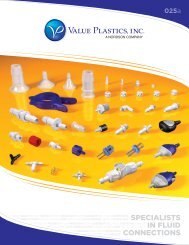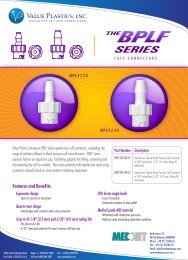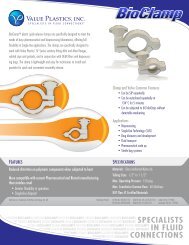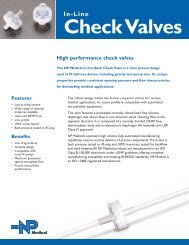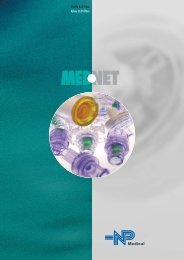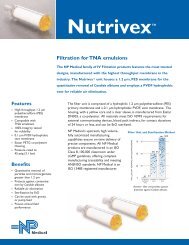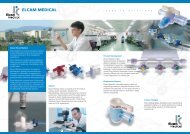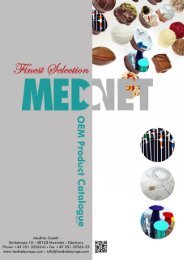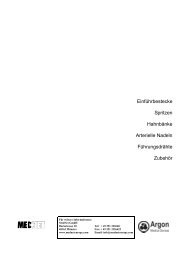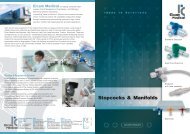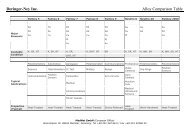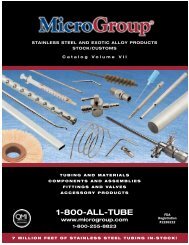Radiopaque Medical Devices Containing Bismuth Oxychloride ...
Radiopaque Medical Devices Containing Bismuth Oxychloride ...
Radiopaque Medical Devices Containing Bismuth Oxychloride ...
Create successful ePaper yourself
Turn your PDF publications into a flip-book with our unique Google optimized e-Paper software.
5DGLRSDTXH 0HGLFDO 'HYLFHV &RQWDLQLQJ %LVPXWK 2[\FKORULGH<br />
4LQ\XQ 3HQJ<br />
(0' &KHPLFDOV ,QF<br />
$Q $IILOLDWH RI 0HUFN .*D$ 'DUPVWDGW *HUPDQ\<br />
+DZWKRUQH 1HZ
<strong>Bismuth</strong> subcarbonate has limited use and is usually compounded with low melting point polymers since it<br />
decomposes at temperatures higher than 225 o C. Its use has decreased due to its thermal instability and poor<br />
dispersibility<br />
<strong>Bismuth</strong> trioxide has a strong yellow color which may not be desirable if white or other colors are needed.<br />
Furthermore, it makes tubing with rough surfaces.<br />
<strong>Bismuth</strong> oxychloride powder is white with excellent skin feel. It can be compressed easily and dispersed well in<br />
polymers.<br />
Tungsten has a very high density and can be loaded up to 90% by weight into polymers, which makes it useful<br />
for highly radiopaque devices, such as very thin-wall catheters. However, tungsten has a black color, is<br />
flammable and very abrasive. It can wear out the processing equipment extremely fast.<br />
Table 1: Properties of various fillers<br />
)LOOHUV 'HQVLW\<br />
J FP �<br />
$WRPLF<br />
QXPEHU<br />
&RORU 6WDELOLW\ 'LVSHUVLELOLW\ 6XUIDFH<br />
VPRRWKQHVV<br />
Barium sulfate 4.5 56 white stable good good<br />
<strong>Bismuth</strong> oxychloride 7.7 83 white stable up to<br />
600 o C<br />
<strong>Bismuth</strong> subcarbonate 8.0 83 white stable up to<br />
225 o C<br />
good good<br />
poor to fair fair<br />
<strong>Bismuth</strong> trioxide 8.9 83 yellow stable fair to good poor to fair<br />
Tungsten 19.35 74 black stable 1<br />
good poor<br />
1<br />
Tungsten is flammable. Proper care must be taken when heating tungsten metal powder.<br />
When a special color is required for a device, the desirable fillers are certain grades of bismuth oxychloride<br />
powders and/or barium sulfate since they have white color with relatively good transparency.<br />
&RPSDUDWLYH VWXG\ RI ELVPXWK R[\FKORULGH DQG EDULXP VXOIDWH<br />
A comparative study of catheter tubing filled with a bismuth oxychloride powder or barium sulfate was<br />
performed and the results are listed in Table 2.<br />
Table 2: Mechanical property data* of catheters filled with bismuth oxychloride or barium sulfate<br />
)LOOHUV %L2&O %D62�<br />
Weight (%) 25 25<br />
Tensile, breakload (MPa) 35.4 39.9<br />
Elongation (%) 92.5 81.5<br />
Stiffness (mg) 375 288<br />
*The polymer is polyurethane with a hardness of Shore 84A. Stiffness was measured on a Gurley Stiffness<br />
tester. Tensile strength was measured by an Instron machine.<br />
It appears that the mechanical properties of both catheter samples filled with bismuth oxychloride or barium<br />
sulfate are similar. At equal weight, it is clear that the barium sulfate filled catheter is much less radiopaque<br />
than the bismuth oxychloride filled catheter (Figure 1).<br />
2
Figure 1. X-ray image of catheters filled with identical amount of barium sulfate (left) and<br />
bismuth oxychloride (right)<br />
SEM pictures of cross-sections of the tubing samples were taken to compare the dispersibility of bismuth<br />
oxychloride and barium sulfate in the polymer (Figure 2). It is apparent from the SEM pictures that barium<br />
sulfate filled tubing has a very grainy appearance. However, both bismuth oxychloride and barium sulfate are<br />
generally well-wetted.<br />
Figure 2. SEM pictures of cross-section tubing of barium sulfate (left) vs. cross-section tubing<br />
of bismuth oxychloride (right)<br />
It is well known that the loading level (by volume) of filler affects the mechanical properties of a plastic.<br />
Because of the differences in density, the weight percentage of bismuth oxychloride and barium sulfate was<br />
converted to volume percentage and the data are listed in Table 3.<br />
Usually, it is not recommended to fill a polymer with excessive quantity of filler in terms of volume percentage<br />
in order to maintain the polymer’s mechanical properties. In the case of barium sulfate, 20 - 40% by weight is<br />
commonly used to make catheters with reasonable radiopacity and has little effect on the physical properties of<br />
the plastics. At 40% by weight loading level, barium sulfate occupies 14.0% of the total volume of the finished<br />
compound, while bismuth oxychloride powder represents only 8.7% by volume. Furthermore, it has much<br />
higher radiopacity than the same amount of barium sulfate. Therefore, when higher radiopacity is needed,<br />
barium sulfate is apparently not satisfactory since excessive loading will cause the loss of mechanical properties<br />
of the polymer. On the other hand, up to 50% by weight of bismuth oxychloride powders can be used to fill the<br />
polymer and still maintain the required integrity of the polymer.<br />
3
Table 3: Volume versus weight percentage of bismuth oxychloride powders and barium sulfate<br />
)LOOHU %DULXP %LVPXWK<br />
VXOIDWH R[\FKORULGH<br />
Weight % Volume % Volume %<br />
10 2.6 1.6<br />
20 5.8 3.5<br />
30 9.5 5.8<br />
40 14.0 8.7<br />
50 19.6 12.5<br />
60 26.8 17.7<br />
70 36.3 25.0<br />
Nowadays, new generation X-ray machines are operated at higher radiation energy (kVp) and consequently<br />
higher radiopaque materials are essential to provide sufficient attenuation of the radiation energy. Barium<br />
sulfate filled catheters will not be able to exhibit a bright and sharp image due to its lower K-edge energy, which<br />
as a rule of thumb should be comparable with the kVp of a machine. Therefore, the development of new<br />
instrument technology also accounts for the increasing popularity of bismuth oxychloride powders in catheter<br />
applications.<br />
3URSHUWLHV RI ELVPXWK R[\FKORULGH<br />
<strong>Bismuth</strong> oxychloride is versatile and has been used in various applications, such as cosmetics and personal care<br />
products in addition to medical devices. Its usage in medical devices, particularly in catheters, has increased<br />
steadily due to many of its advantageous attributes.<br />
<strong>Bismuth</strong> oxychloride is non-toxic and stable under normal compounding and extrusion conditions. It has a high<br />
specific gravity (7.7 g/cm 3 ) and does not melt and only starts to decompose at temperatures above 600 o C.<br />
<strong>Bismuth</strong> oxychloride renders very smooth skin feel due to its layered crystal structure (Figure 3) and partial<br />
agglomeration (Figure 4), and it offers a smooth, silky finished surface for the plastics. The surfaces of bismuth<br />
oxychloride powder crystals are also somewhat hydrophobic, therefore, they disperse readily in the oily and<br />
hydrophobic systems.<br />
<strong>Bismuth</strong> oxychloride is compatible with a wide range of polymer resins used in catheter applications, such as<br />
nylon elastomer, polyurethane, polyethylene copolymers, etc.<br />
Figure 3. Schematic drawing of the crystal structure of bismuth oxychloride<br />
4
Figure 4. SEM picture of a bismuth oxychloride powder<br />
<strong>Bismuth</strong> oxychloride not only offers high radiopacity, but also can be used in combination with other colorants<br />
if colors other than white are desired. It can be blended with barium sulfate for a broad range of applications.<br />
It has not been clearly understood why bismuth oxychloride is sensitive to UV light. Under direct sunlight, it<br />
turns gray. However, this darkening effect is partially reversible, i.e. if a darkened bismuth oxychloride is kept<br />
in the dark, it will become white again, but not to the original whiteness prior to the light exposure. Many<br />
efforts have been made to stabilize bismuth oxychloride against the UV light and have yielded commercially<br />
available bismuth oxychloride powders with much improved light stability. Catheters made with more light<br />
stable bismuth oxychloride powders exhibit better light stability than those made with regular bismuth<br />
oxychloride powders. In general, it is recommended to use UV absorbers in clear packaging to prevent<br />
photograying of the device prior to use.<br />
*HQHUDO PDQXIDFWXULQJ SURFHVV RI ELVPXWK R[\FKORULGH SRZGHUV<br />
High purity bismuth oxychloride powders can be manufactured by hydrolysis of bismuth salts (derived from<br />
pharmaceutical grade bismuth metal) in an acidic aqueous system in the presence of excess chloride ions.<br />
Bi 3+ + Cl - +H2O → BiOCl + 2H +<br />
Under different precipitation conditions, such as temperature, pH, concentration, various types of bismuth<br />
oxychloride powders can be obtained. It is possible to produce bismuth oxychloride with extremely little<br />
mechanical or chemical impurities and to meet the specifications for cosmetic and external applied drug<br />
applications according to 21 CFR 73.1162 and 73.2162 (2).<br />
Furthermore, bismuth oxychloride powders can be produced with very low moisture content which is<br />
advantageous for compounding with plastics. Because of the crystalline (non-porous) nature and the smooth<br />
surface of the crystal platelets, the oil absorption of bismuth oxychloride is relatively low, in the range of 20-60<br />
g/100g.<br />
<strong>Bismuth</strong> oxychloride powders contain mostly irregular platelet-shaped crystals. Typically, they have a diameter<br />
of 2-20 µm and a thickness of less than 1 µm and tend to agglomerate to some extent. Various grades of<br />
bismuth oxychloride powders are commercially available with different opacity, bulk density, and light stability.<br />
/DVHU PDUNLQJ SURSHUW\ RI ELVPXWK R[\FKORULGH SRZGHU<br />
In addition to the radiopacity that bismuth oxychloride renders, it was discovered that bismuth oxychloride also<br />
improved the laser marking property of the plastic in which the bismuth oxychloride was compounded (3).<br />
Photos shown below (Figure 5) are laser marked HDPE chips containing various levels of bismuth oxychloride<br />
powder (1-25% w/w). It appears that when low concentration of bismuth oxychloride is used, the mark is<br />
5
visible but blurry. Once the loading level of bismuth oxychloride is increased up to 10%, clear marks with good<br />
resolution are obtained.<br />
1% BiOCl 5% BiOCl 10% BiOCl<br />
15% BiOCl 20% BiOCl 25% BiOCl<br />
Figure 5. HDPE chips filled with various levels of bismuth oxychloride powder<br />
Laser marking property of catheters with 25% loading of bismuth oxychloride or barium sulfate is compared in<br />
Figure 6. It is apparent that the catheter with barium sulfate has no mark while the one with bismuth<br />
oxychloride exhibits very sharp and clear mark.<br />
Figure 6. Laser marked polyurethane filled with 25% barium sulfate (left) or 25% bismuth oxychloride (right)<br />
This advantageous property of bismuth oxychloride can help the manufacturers of medical devices to use less or<br />
no laser marking materials in their products to achieve the required marks for their devices if laser marking is<br />
desired.<br />
6XPPDU\<br />
<strong>Bismuth</strong> oxychloride is an unique filler and renders many advantages over other fillers for radiopaque medical<br />
devices. It provides high radiopacity and sharper contrast image than barium sulfate, allows high loading<br />
without adverse effect on the mechanical properties of the polymers and facilitates more efficient manufacturing<br />
process because of its excellent powder dryness. Furthermore, bismuth oxychloride can improve the laser mark<br />
property of the plastics.<br />
6
%LELORJUDSK\<br />
1. Gachter R. and Muller H., 3ODVWLFV $GGLWLYHV, Third Edition. Carl Hanser Verlag, Munich, Germany<br />
(1990).<br />
2. Code of Federal Regulations, Food and Drugs, 21 Parts 1 to 99 (Revised as of April 1, 2004).<br />
3. Peng, Q, Pending patent application (2005).<br />
7



